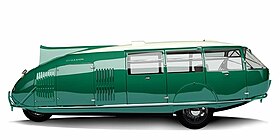Dymaxion Car
| Dymaxion car | |
|---|---|

Dymaxion replica
|
|
| Overview | |
| Manufacturer | The Dymaxion Corporation Bridgeport, Connecticut 41°10′02.1″N 73°10′49.1″W / 41.167250°N 73.180306°W |
| Also called | 4D Transport |
| Production | 1933 three prototypes built |
| Assembly | Bridgeport, Connecticut |
| Designer | Bucky Fuller with Starling Burgess and Isamu Noguchi |
| Body and chassis | |
| Class | Concept car |
| Body style | Sheet aluminum on ash frame |
| Layout | RF layout |
| Platform | Varied per prototype: double or triple hinged, cromoly steel |
| Powertrain | |
| Engine | Ford flathead V8 |
| Transmission | Ford |
| Dimensions | |
| Length | 20 ft (6,096.0 mm) |
The Omni-Media-Transport:
With such a vehicle at our disposal, [Fuller] felt that human travel, like that of birds, would nolonger be confined to airports, roads, and other bureaucratic boundaries, and that autonomous free-thinking human beings could live and prosper wherever they chose.
— Lloyd S. Sieden, Bucky Fuller's Universe, 2000
To his young daughter Allegra:
Fuller described the Dymaxion as a "zoom-mobile, explaining that it could hop off the road at will, fly about, then, as deftly as a bird, settle back into a place in traffic."
The Dymaxion car was designed by American inventor Buckminster Fuller during the Great Depression and featured prominently at Chicago's 1933-1934 World's Fair. Fuller built three experimental prototypes with naval architect Starling Burgess — using gifted money as well as a family inheritance — to explore not an automobile per se, but the 'ground-taxiing phase' of a vehicle that might one day be designed to fly, land and drive — an "Omni-Medium Transport". Fuller associated the word Dymaxion with much of his work, a portmanteau of the words dynamic, maximum, and tension, to summarize his goal to do more with less.
The Dymaxion's aerodynamic bodywork was designed for increased fuel efficiency and top speed, and its platform featured a lightweight hinged chassis, rear-mounted V8 engine, front-wheel drive (a rare RF layout), and three wheels. With steering via its third wheel at the rear (capable of 90° steering lock), the vehicle could steer itself in a tight circle, often causing a sensation. Fuller noted severe limitations in its handling, especially at high speed or in high wind, due to its rear-wheel steering (highly unsuitable for anything but low speeds) and the limited understanding of the effects of lift and turbulence on automobile bodies in that era — allowing only trained staff to drive the car and saying it "was an invention that could not be made available to the general public without considerable improvements." Shortly after its launch, a prototype crashed after being hit by another car, killing the Dymaxion's driver. Subsequent investigations exonerated the prototype.
...
Wikipedia
